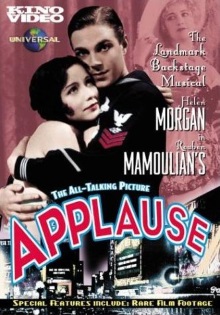
With Applause, we move from the silent film era to the talkies. Surprisingly, this isn’t just one of the earliest talkies, it also pioneered a number of interesting innovations while being its director Roubien Mamoulian’s first feature film. Unfortunately, its technical achievements are much more interesting than its annoying characters, unsatisfying plot and simplistic moralization.
Helen Morgan, herself apparently a noted nightclub performer and owner, stars as burlesque performer Kitty Darling who popularity is fading as she ages. She is also a single mother who sends her daughter to a convent to be raised in order to shelter her from the tawdriness of show business. But when her sleazy boyfriend, who naturally cheats on her, discovers the existence of the daughter, he forces Kitty to bring her home and join their show, knowing that he can make more money out of a younger star.
It’s a pretty standard morality play with the daughter April having to choose between staying in the troupe despite her disgust with the burlesque scene in order to help her mother or leaving to seek her own happiness. Unfortunately as in many morality plays, the options feel completely plot-driven and therefore unrealistic. April just so happens to meet the perfect man on her first night out in the city alone who can whisk her away to a lifetime of bliss if she so chooses. Kitty is either too besotted with her lover or too drunk all of the time to notice what a sleazeball her lover is and ignore anything he says. This is the kind of story in which drama happens only because the protagonists never sit down and really talk to each other.
Helen Morgan’s performance is notable, though my wife was none too impressed with the quality of the burlesque performances. I really didn’t like the crude manner in which the director hammered home the ugliness of the shows: plenty of shots of leering men’s faces, interspersed with female bouncing flesh. Worst of all might be the abrupt ending, which if you’re feeling charitable you might call an attempt at a bittersweet conclusion and if you’re not a total cop out since it ends without April knowing anything about Kitty’s fate.
That leaves just the technical aspects to talk about and it’s not just in the sound department either. An early scene demonstrates Mamoulien’s willingness to experiment. As April is about to leave the convent for good, the camera follows her from behind as she walks slowly, angled upwards slightly to give the audience an impression of the quiet grandeur of the sanctuary she has to leave. The camera movement is jerky and unpolished, but is recognizably a early example of a filming technique that is common today.
As for the sound, Mamoulien realizes that far more is possible than merely enabling audiences to hear the actors talk. Kitty sings to April to establish the mother-and-daughter bond in the minds of the audience. April’s sense of fear and confusion as she arrives in the big city for the first time is heightened by the bustle and honking of cars. This is apparently also one of the first films that have scenes that are shot on location instead of being made entirely in studio lots. That’s why there are real city streets, a subway station, the New York skyline, and even the Brooklyn Bridge.
Still, these technical achievements, as impressive as they are in their historical context, don’t make Applause a good film, nor even a very enjoyable one. The rest of the film, from its writing, its characters, its to its meaning, is middling to bad, making this very much one only for the history books.